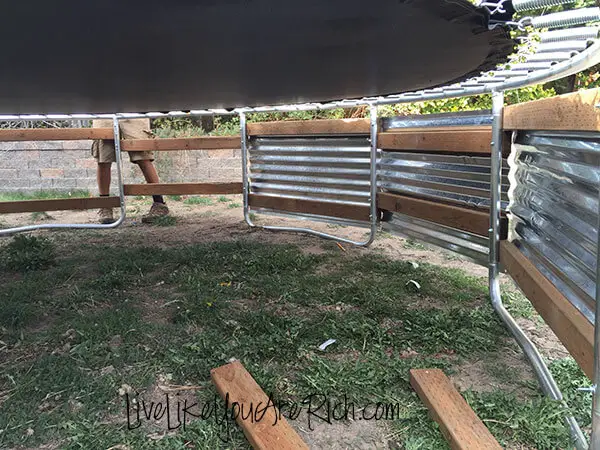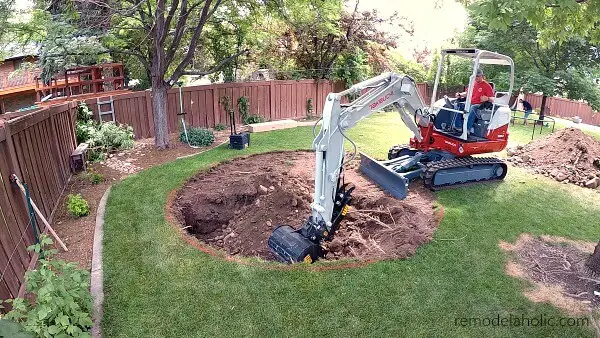If your kids are anything like ours, they need to jump their jiggles out on a daily basis. A backyard trampoline takes the cake to get loads of physical energy out and have plenty of fun.
But, how do you make a trampoline fit best in your yard? The answer might be to install it into the ground! It’s safer, looks nicer, and is easier for the kids to climb on and off of. If you already have a trampoline at home, you might be wondering if you can just dig a hole for it instead of having to buy a specific inground model.
Backyartisan has got your back! We’ve researched and gathered all the answers you need to know for this DIY project.
Quick answer: can you put a normal trampoline in the ground?
Yes, an above ground trampoline can be used in the ground, as long as it is installed properly. And we’ll stress that – an above ground trampoline must be installed correctly when used inground, or it presents a serious safety risk.
In this article, we’ll cover all you need to know about how to sink a trampoline and how to do it safely.
Pros and Cons of Using a Normal Trampoline In Ground
As with every DIY yard task, we’ve got to talk pros and cons! Before you decide to start a project, you’ve got to make sure it’s even worth it for you to do. Look at the points below to help you decide whether this is a DIY for you. You can also check out our guide on common sunken trampoline problems.
Pros
An in-ground trampoline is generally considered safer than an above ground trampoline.
The number one cause of a trampoline injury is falling off the edge. When a trampoline is sunk in the ground, there are essentially five fewer feet to fall from!
You won’t need to fuss with installing a net on your in-ground trampoline if you don’t want to. But don’t be fooled into thinking it will be impossible to get hurt if you bury your trampoline. With any trampoline comes a safety risk, but an in-ground model is inherently safer.
Cost
Though you’re likely to spend some money on this project, using a standard trampoline for the job will save you a good amount of cash. In-ground trampolines cost about $2,500 on average, and that doesn’t include the price of excavation. The cost of burying a standard trampoline is considerably cheaper and covered in detail further on in this article.
It’s easier for kids to access.
No ladders or climbing is necessary. An inground trampoline sits flush with the earth, making it easy for kids to simply walk into the jumping mat.
Along with being easier to access, an in-ground trampoline is also more fun. Why? Maybe only the kids know, but it’s certainly true from parent-report! Kids just have more fun on an in-ground trampoline.
In-ground trampolines look nicer in your yard.
As much fun as they are, trampolines can do quite the doozy on your yard feng shui! Dip it into the ground, though, and you’ve got a much more pleasing aesthetic.
Cons
Sinking a trampoline takes work…or money.
Installing a trampoline under the ground is a serious job. If all you’ve got is a shovel, you’ve got your work cut out for you. Whether you contract the work out or rent a mechanical digger (expect a four-hour dig job), either one will cost you money that installing an above ground trampoline wouldn’t.

Besides just digging the hole, you’re also in for building your own retaining wall and frame support. People have used cinder blocks, wood, or metal sheets.
Though an in-ground trampoline looks better in your yard, right after your DIY project, you’ll have a lot of cleaning up. You’ve got to figure out where to put all the dirt you just hauled up, and digging machinery will do a number on your grass.
It’s far more difficult to move or store a trampoline under the ground.
After you’ve dug a massive hole in the ground for your trampoline, it’s not all that simple when it comes to storing the thing for winter or even moving it to another spot in the yard. However, it is nice not to have to move the trampoline to mow the lawn!
What’s under there…?
Your kids won’t be the only critters that enjoy an inground trampoline. You might end up with a family of rabbits that claim the trampoline hole as their warren! Animals that live in the ground may be attracted to the space underneath or even accidentally get trapped. For this reason, proper installation is really important.
How Much Does It Cost to Sink an Above-Ground Trampoline Inground?
Leaving your above ground trampoline as-is will certainly be the cheaper option. But, if you’re committed to changing it up and want to switch to an inground install, the first thing that comes to mind might be, “how much will this cost?”
If you’re handy with a shovel, have someone who owes you a favor, and a place in your yard that needs a bunch of excess dirt, it won’t be very expensive at all!
However, most people wanting to sink their trampoline into the ground likely want this to be a quick task that can be completed in a day. In that case, you’re looking to hire out for manual labor. The cost of digging the hole and hauling away the dirt may cost you around $200-500. To rent a backhoe from your local hardware store should be less than $200. As for the full installation, you’re looking at up to $2,000 for the job.
Why an Inground Trampoline Model is a Better Option
We’ve covered the pros and cons of installing your trampoline inground, but here we’ll discuss why a specific inground model is a better option!
A standard trampoline is not specifically made to be used inground. While it is possible to dig a hole for it and install it safely, it will take a lot more work than a trampoline model that is specifically built to be underground. We’ll cover a few hot points for why it’s best to choose an inground trampoline for this project.
Built-in retaining wall
In-ground trampoline models were made to be installed…well, in the ground! That means that they’ll come fitted with a built-in retaining wall. Instead of a metal frame, the structural bottom edge of the trampoline is a pre-engineered support wall.
Size
Above-ground trampolines are taller than inground models. So, if you decide to work on this project with your above-ground bouncer, you will be digging a much bigger hole.
Materials
When you bury the frame of a trampoline, it intrinsically increases the moisture levels underneath. Above-ground trampolines aren’t necessarily built to withstand this climate change. However, inground models are. Spring pads are typically vented, and the frames are constructed with rust-resistant material.
Tips to Install a Normal Above-Ground Trampoline In the Ground
Bottom line, can you install an above ground trampoline as an in-ground setup? Yes, you can, but you’ll certainly be working for it. We’ve covered the drawbacks of this project and discussed why an inground trampoline model is the superior choice. Yet, you might still be interested in sinking your above ground trampoline!

For the folks who want to DIY this project, we have a few tips to make the task go a little more smoothly for you.
- Decide where to put it! Before digging a colossal hole, you want to be certain you’ve picked the right spot. Remember that you may need to contact city officials before you dig. Just call 811. It’s free, but expect at least a 48-hour turnaround for officials to come out.
- Dig your hole:
- Wide: 1-2 feet wider than the diameter of your trampoline. For example, if your trampoline is 12 feet wide, you’ll need to dig a 13 or 14-foot wide hole.
- Deep: a few inches deeper than the height of your frame. Make sure your hole is deeper in the center than on the edges.
- Install a retaining wall inside the hole to prevent dirt slides and hole erosion.
- For wet climates or hard-packed soil, installing a drain at the bottom of the hole can be beneficial.
- Before you insert your trampoline into the hole, remove the mat and springs. This will make it easier to check if the frame is level and make structural adjustments to the hole.
After installation, use these tips to solve a few of those “cons” mentioned above:
- Use pool noodles to close the gap between your trampoline frame and the hole to keep animals or little hands from getting stuck underneath.
- Purchase vented pads for the springs to allow for airflow under the trampoline.
- Landscape around the trampoline to really make it a part of your yard! Add smooth rock gravel, stepping stones, or even low plants or shrubs to blend it into your landscaping.
Final Comments
Now you’ve got the low-down on how to put that trampoline down-low! Submerging a trampoline into the ground is a great option for providing a safer and more easily accessible play area. Thanks for using The Backyartisan as your DIY guide!